F-86K Export Interceptor
On 22nd January 1953, Air Materiel Command (AMC) issued a request for
a Mutual Defense Assistance Program (MDAP) interceptor, in order to
begin equipping NATO countries. Despite firm stipulations that the aircraft
would have a two-man crew, NAA looked to designing a simplified version
of the F-86D, which would also incorporate fire control equipment in
place of the still-secret Hughes E-4 system. This equipment, known as
the MG-4 fire control system, was designed and built by NAA's Electro-Mechanical
Division at Downey.
MG-4 Fire Control System
installation in the F-86K nose section.
The MG-4 was
linked to an AN/APA-84 computer, which would provide intercept information
to a cockpit-mounted scope in the same manner as the F-86D. To give
a back-up to this system, the aircraft would also mount an A-4 gun/bomb/rocket
sight for manual control. North American's designers had no problems
in modifying the design to accept the specified four, 20-mm cannon armament
in place of the rocket system, but differences in weight between the
two installations required an 8-inch (203 mm) forward fuselage extension
to regain the centre of gravity position.
F86K side-view showing the staggered 8-inch insert added forward
of station 187.4 (upper fuselage) and forward of 221 at the bottom.
This was done to avoid lengthening the mainwheel bay.-
In most other respects,
the new aircraft, accepted by AMC as the F-86K, differed little from
the F-86D, and was fitted with an afterburning J47-GE-33 engine of
7,650-lb. (3469 kg) thrust.
F-86K powerplant - the J47-GE-33
In order to furnish two
prototypes of the F-86K, Contract AF-25402 was signed on 14th May
1953 and allotted two F-86D-40 aircraft from the Inglewood production
line to be converted to YF-86K prototypes. As NA-205s, the first of
these machines, 52-3630, was flown at Los Angeles on 15th July 1954.
NAA test pilot Raymond Morris flew the aircraft on this occasion,
being initially unarmed and powered by a J47-GE-17B.
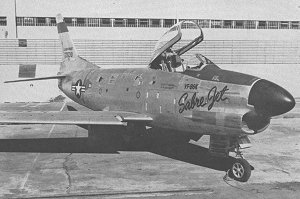
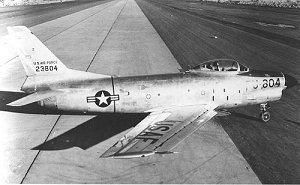
The
number 1 YF-86K 52-3630 (left) and the number two machine, 52-3804 (right).
As rolled out, the no.1 aircraft carried no armament, the second machine
just the rear two cannon.
Armament for production versions would be a group of four 20-mm M-24A1
cannon with 132 rounds per gun, firing at 700 rounds per minute. The
cannon armament was installed on either side of the cockpit, much
the same as the day fighter F-86A/E/F installation. A new access panel
was set into each side of the fuselage.
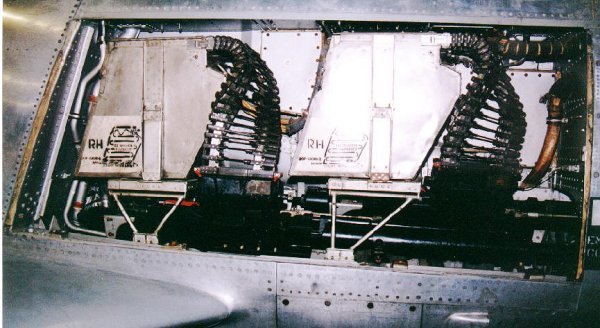 Right-hand F-86K armament
showing ammunition containers above and the two 20mm cannon below
Right-hand F-86K armament
showing ammunition containers above and the two 20mm cannon below
The second prototype, 52-3804, was completed initially with just the
lower pair of cannon, but later in the test programme, both sets were
fitted. It is interesting to note that the upper pair of cannon, which
had their gun muzzles adjacent to the engine air intake, were fitted
with the gas-dispersing C-shaped fitting as seen on GunVal F-86Fs
and cannon-armed F-86Hs. The lower and thus rearmost cannon, with
its muzzle a good 30 inches (762 mm) aft of the intake, was not configured
in this way. However, to further purge gas from the gun compartment,
five prominent ducts were cut into the main access panel. Both prototypes
were retained for testing by North American, eventually being scrapped
at McLellan AFB in 1957.
FIAT in Italy signed a license production agreement on 16th May 1953,
under which F-86Ks would be built at the company's Turin-Caselle plant
from US-supplied components. Further to this agreement, on 18th May,
MDAP funds were committed for NAA to supply 50 sets of F-86K parts
under Contract AF-25402, signed on 28th June 1954. These aircraft
would be assigned USAF serials, but after assembly they would wear
Italian Matricola Militare (MM) serial numbers.
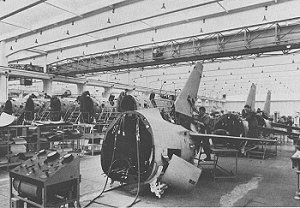
F-86K
production underway at Turin-Caselle. The tail section in the foreground
is having hydraulic functional checks prior to installation onto the
production line.
Meanwhile, NAA was contracted
under AF-26479 on 18th December 1953 to initiate construction of 120
NA-213 F-86Ks, to cater for delivery of aircraft to Norway and the
Netherlands. FIAT-assembled machines would then equip the French and
German air forces, as well as that of the Italians.
The first NAA-built F-86K, 54-1231, was flown on 8th March 1955, and
this aircraft was also retained by North American as the production-standard
aircraft.
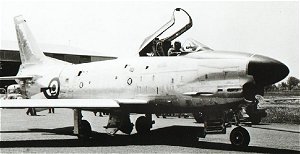
54-1231, NAA's first
production F-86K, was retained by the company until 1960 when it was
delivered to Norway as a final replacement for 54-1235, which was
lost prior to handover.
Deliveries were completed in December 1955, with sixty being shipped
out to the Royal Norwegian Air Force and fifty-nine to the Royal Netherlands
Air Force. On 23rd May, just over two months after the first NAA-built
production model flew, NAA representative Col. Arthur DeBolt took
FIAT's first machine into the air from Turin.
(missing
photo)
FIAT's first F-86K (53-8273) rolls out for first flight on 23rd May
1955. (Howard Levy)
Further contracts
were subsequently signed with FIAT for F-86K assembly: seventy under
NA-221 (Contract AF-28086, signed 8th September 1955), fifty-six NA-232s
(Contract AF-30742, signed 31st May 1956) and forty-five NA-242s (amended
Contract AF-30742, signed 4th September 1956). Significantly, the
last forty-five aircraft were fitted with the extended-span wing as
used on the F-86F-40 and F-86L models.
FIAT-assembled F-86Ks began to be assigned to Italian AF units in
November 1955, and the last Turin-built Sabre was received by the
German Luftwaffe in June 1958. Ironically, by this time, it had been
agreed that the F-86D and its fire control system was suitable for
export. Service details of the F-86K are covered later.
Specifications
- F-86K:
Weights:
Empty Weight 13,367 lb. (6061 kg)
Combat Weight 16,252 lb. (7370 kg)
Max. Takeoff Weight 20,171 lb. (9147 kg)
Dimensions:
Wingspan 37 feet 1 inch (11.3 m) - 39 feet 1 inch (11.92 m) for extended
wing
Length 40 feet 11 inches (12.49 m)
Height 15 feet (4.5 m)
Wing Area 287.9 sq. feet (26.78 m?) - 313.4 sq. feet (29.15 m?) for
extended wing
Performance: (One General Electric J47-GE-33 of 7,650 lb. (3469
kg) thrust with afterburner)
Maximum speed 692 mph (1113 km/h) at sea level
612 mph at 40,000 feet (984 km/h at 12192 m)
Initial Climb Rate 12,000 feet per minute. (3657 m/min)
Service Ceiling 49,600 feet. (15118 m)
Combat Range 272 miles (437 km)
Ferry Range 744 miles (1197 km)
F-86K Production:
Serial No. Model Construction Numbers
52-3630 YF-86K NA-205-1 (NAA)
52-3804 YF-86K NA-205-2 (NAA)
53-8273 to 8322 F-86K NA-207-1 to 50 (FIAT)(MM 6185 to 6234)
54-1231 to 1350 F-86K NA-213-1 to 120 (NAA)
55-4811 to 4880 F-86K NA-221-1 to 70 (FIAT)
55-4881 to 4936 F-86K NA-232-1 to 56 (FIAT)
56-4116 to 4160 F-86K NA-242-1 to 50 (FIAT)
Service
Use
France
Following W.W.II, French industry took some time to recover, and this
was especially true in the aircraft manufacturing industries. Thus,
to begin rebuilding the French Air Force - the Armee de l'Air - many
foreign types were purchased, and in 1951, F-84Gs and T-33 trainers
started to arrive from the United States, and later on, F-84Fs and
F-100Ds began to equip French squadrons. These machines were supplied
under MDAP as France was a NATO member at this point. (France withdrew
from NATO in 1966, much to the chagrin of member nations, not least
the United States).
In the interceptor role, France had planned to deploy the Dassault
Mirage, the prototype of which flew in 1955. However, delays in getting
the production Mirage IIIC and Vautour IIN into service saw the Armee
de l'Air looking to buy an interim aircraft off the shelf. The F-86K
was chosen for this requirement.
A new unit was formed to
receive these Sabres, 13e Escadre de Chasse Tout Temps (ECTT - All
Weather Fighter Wing). The unit was activated on 1st March 1955 at
Lahr AB in West Germany under the leadership of Commandant Risso.
However, delivery of the first F-86Ks did not begin until some time
later, and initially eight T-33s were assigned so that crews could
begin blind flying instrument training. To familiarise themselves
with the F-86K, five 13e ECTT pilots were also detached to Istrana
AB in Italy, while ground personnel were trained by four USAF instructors
who set up a Field Training Detachment at Lahr. Finally, in June 1956,
two Erco MB-18 flight simulators arrived at Lahr so that flight training
could be carried out.
This situation continued
until 4th September 1956 when the first of sixty FIAT-built F-86Ks
(55-4814) arrived at Lahr, being officially accepted by the French
the following day. The delivery of F-86Ks triggered the formation
of two Escadrons (squadrons) within 13e ECTT on 1st October; Escadron
1 'Artois' with commanding officer Capitaine Fonvielle and Escadron
2 'Alpes' under Capitaine Brisset. In French service, these units
were known as EC.1/13 and EC.2/13 respectively, denoting their assignment
to 13e ECTT.
By the end
of 1956 the unit had flown 189 hours in the F-86K, comprising 196
missions. On 1st April 1957, 13e ECTT moved into a new purpose-built
base at Colmar-Mayenheim in France, at this time possessing fifty-three
of the planned sixty machines. Delivery was completed in June with
the arrival of 55-4816 and 4818 at Colmar.
(missing
photo)
55-4814 in the early '13-G' codes of EC.2/13 'Alpes'.
This aircraft was scrapped after an undercarriage collapse
on 28 Feb 62.
To differentiate between the two Escadrons, the aircraft were assigned
individual codes; EC.1/13 using 13-GA to GZ and EC.2/13 having 13-HA-to
HZ. In practice however, these code allocations were reversed, and rather
than completely repaint all codes, it was decided in late 1958 that
a stroke of the paint brush would change EC.2/13's '13-G' to '13-Q'
and EC.1/13 '13-H' to '13-P', thus restoring the alphabetic order of
the squadron codes. This only gave fifty-two code permutations, and
aircraft that were 'spare' took on codes in the '13-SA' range.
Armee de l'Air F-86Ks were immediately involved in NATO exercises, participating
in 'Counter Punch' in late 1957, followed by 'Rebecca' in which 13e
ECTT took up a 24-hour alert posture. By the end of 1957, more than
2,000 hours had been flown on the F-86K fleet. This was tempered by
the first loss of a French F-86K when on 13th April 1957 55-4842 landed
short at Colmar, causing the left undercarriage leg to break, Pilot
Lt. Cavat was uninjured, but the Sabre was uneconomical to repair. A
further landing accident on 11th June involved 55-4855, the aircraft
running off the runway at Colmar. This time no damage was incurred.
Sadly, the start
of 1958 also marked the first and only fatal F-86K accident in French
service. On 7th January a radio mechanic was sucked into the intake
of a running Sabre and killed. At the end of May 1958, exercise 'Full
Play' began, to simulate a large-scale attack by atom bombers. F-86Ks
were the main adversary and at the end of the exercise on 5th June had
flown 174 sorties by day and fifty at night. The concentrated flying
schedule was continued when 13e ECTT deployed to Cazaux on 16th June
for gunnery practice. The F-86Ks fired at targets trailed by Ouragan
and B-26 aircraft.
On the night
of 3rd November 1958, EC.2/13 was just reaching the end of a mass night
sortie. No doubt eager to get back safely on the ground, Lt. Hervouet
landed wheels-up at Colmar. The crash started a small fire and also
blocked the runway, Hervouet managing to jump clear while the fire was
put out. However, with the runway blocked, the airborne remainder of
the squadron was forced to divert into Lahr, where the night's misfortune
was compounded when the nosewheel of Capt. Mayot's F-86K broke on landing.
Mayot was uninjured, and fortunately both Sabres, 55-4867 and 4843 respectively,
were repaired.
(missing photo)
F-86K 55-4876 of EC.1/13 'Artois'.
This aircraft was scrapped at Chateauroux in 1963.
During 1959 all F-86Ks began to be routed through FIAT in Turin for
IRAN (Inspect and Repair As Necessary) overhaul and modification of
mainplanes to 'F-40' specification with extended leading edges and increased
span. At about the same time, many French F-86Ks had a long red/white/red
band applied to each fuselage side in an effort to increase their visibility
in the air. This had a valid purpose; despite the application of these
markings on 28th October 1961, 55-4855 and 55-4867 collided in flight,
though both machines and pilots recovered safely to base. Another problem
encountered by French F-86Ks was that of engine failure, sometimes caused
by fuel system faults. This resulted in five crashes, four pilots ejecting
successfully, and another surviving the subsequent forced landing.
Further modification began at FIAT in June 1960 with the fitting of
Sidewinder missile launch rails; at least twenty-nine aircraft eventually
being converted, starting with 55-4820. This modification extended
the useful life of the aircraft, but In June 1961 at a fighter meet
at Colmar, two new Mirage IIICs were unveiled in 13e ECTT markings;
the writing was on the wall for the French F-86Ks. But it was not
until January 1962 that EC.1/13 relinquished its Sabres, passing them
to EC.2/13 to begin Mirage conversion. EC.2/13 then also gave up its
F-86Ks in April, but at this time it was decided to form a third Escadron,
EC.3/13, to operate the Sabres while the Mirage conversion was completed.
EC.3/13 took over the '13-SA to SZ' code range.
The transfer of a number
of French F-86Ks to Italy began in early 1962 with the departure of
thirteen aircraft to 51 Aerobrigata on 27th January; a further nine
departed on 13th July.
The F-86K remained in service
until 4th October 1962 when, their usefulness at an end, they were
transferred to USAF control under the terms of MDAP. At the beginning
of June 1963, fifteen airworthy F-86Ks were transferred to Chateauroux
for storage, joining sixteen further F-86Ks already at the base. In
March 1964 all these aircraft were destroyed by explosives. Only one
aircraft survived in France; 55-4841, which was given to the French
and placed on display at the entrance to Colmar AB. It is now proudly
displayed in the Mus?e de l'Air in Paris.
Germany
At the end of the war, Germany's front-line aircraft of the air force
- the Luftwaffe - were either destroyed or shipped overseas for investigation
by the former Allied powers. When the German surrender was signed
on 7th May 1945, literally overnight all military activity was curtailed
and many talented designers were either seconded to research projects
abroad, or moved voluntarily to other countries to continue their
work.
At a NATO meeting in Paris
on 23rd October 1954, member states agreed to allow the formation
of a new German army, navy and air force. When it came to rebuilding
Germany's armed forces, the aircraft procured for the new Luftwaffe
were all purchased from overseas as a result of the post-War provisions.
Nonetheless, progress was rapid. Luftwaffe planning was initially
for 20 wings to be formed, including four of day fighters and three
all-weather fighter wings by 1960. A number of aircraft types were
investigated to fill these roles, including F-86F and F-100D in the
former and the F-94 Starfire in the latter. Eventually, the choice
came down to Canadair Sabres in the day fighter mission and F-86Ks
as all-weather interceptors.
Personnel for the new Luftwaffe
were mainly drawn from wartime pilots and ground crews, though they
had all invariably had little aircraft experience in the intervening
ten years. To make a start, six pilots, including Johannes Steinhof
were trained in the United States, culminating in F-86F flight training
at Nellis AFB. However, during 1955, 7330th Flying Training Wing at
Furstenfeldbruck AB began USAF-based training of Luftwaffe pilots,
using USAFE F-86Fs.
The Luftwaffe
was able to begin its own dedicated Sabre flying training in 1957
when the first German aircraft arrived from the Royal Canadian Air
Force. These machines, seventy-five Sabre 5s, were delivered from
18th February 1957. These aircraft equipped Waffenschule 10 (WS10)
, a training school formed at Oldenburg to convert potential Luftwaffe
Sabre pilots for the tactical fighters - Canadair Sabre 6s and FIAT-built
F-86Ks.
(missing
phtoto)
Streaming its brake 'chute, this JG75 F-86K was previously 55-4920.
It was one of only a handful of short-span K's to serve with the Luftwaffe.
It was damaged beyond repair in October 1959.
With about
sixty-five aircraft on hand, WS10 used the Sabre 5s until 1959 when
brand-new Sabre 6s began to arrive from Canadair. The unit then flew
these aircraft until March 1962 when Luftwaffe day fighter Sabre training
was ceased.
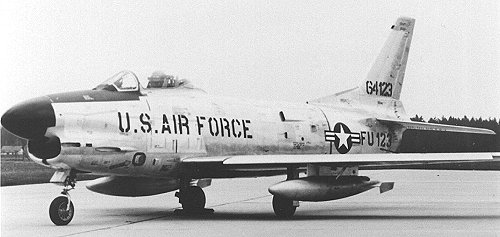
All F-86Ks for the
NATO countries were delivered in USAF markings (they had been supplied
under MDAP). 56-4123, seen upon arrival in Germany became JE-111 with
JG75 and later passed to Venezuela.
While the
day fighter units were coming to operational effectiveness, the delivery
of 88 F-86Ks from FIAT began in 1957. Arriving at Oberpfaffenhofen
from Italy in pairs, the first two were flown in on 22nd July, with
delivery completed just less than a year later on 23rd June 1958.
Prior to delivery, all F-86Ks were inspected and Luftwaffe makings
applied by the Dornier company. All these aircraft had carried USAF
markings for the ferry flight, and in the event, only fifty-seven
actually entered Luftwaffe service. The remaining F-86Ks were crated,
still in USAF colours until disposed of with the operational aircraft.
WS10 began F-86K training in July 1959, enabling pilots to then proceed
to JG74 and JG75, the two units formed to operate the type. WS10 ceased
all Sabre training in July 1962. JG75 was formed at Oldenburg in October
1960, but moved to Leipheim that same month. The unit's aircraft carried
'JE' codes, but they were short-lived, and on 5th May 1961 JG75 disbanded
and passed its Sabres to JG74, the only other wing to operate the
F-86K. Activating at Neuberg in April 1961, JG74 was assigned to NATO
in October of the following year.
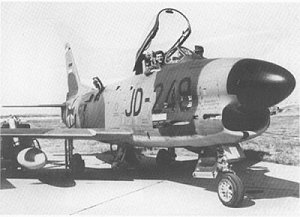
Camouflaged
'JD' coded F-86K of JG74. JD-249 was ex-56-4158 and later became '5627'
with the Venezuelan AF.
All unit aircraft
were camouflaged, the scheme having been introduced during late 1960.
Thus, only a few of JG75's aircraft were thus painted before the wing
disbanded. Luftwaffe use of the F-86K was fairly brief. Slated for
conversion to the F-104G Starfighter, JG74 performed its last F-86K
flight on 5th January 1966. Surviving aircraft and the crated spares
- still in USAF colours - were passed to the Venezuelan Air Force.
(missing
photo)
Something of a teaser, this shot of a camouflaged JG75 machine appears
at first to show the aircraft being scrapped or dismantled. However,
no 'JE-2**' coded machines are listed as being scrapped, and it may
well therefore illustrate a maintenance SNAFU (Peter Sickinger).
Holland
In 1951 the Dutch parliament approved a plan whereby an independent
air force would be created as part of the country's new NATO commitment.
The plan initially suggested that nine day fighter squadrons plus
six night fighter, six fighter bomber and four observation/communications
squadrons would be required. However, later in 1951 NATO air force
arrangements were revised, and the Paris Plan, approved in February
1952 put forward an increase of aircraft assigned to each squadron,
at the same time reducing the number of actual squadrons. Thus, the
Koninklijke Luchtmacht (KLu), created on 27th March 1953, would feature
six day fighter squadrons and three all-weather squadrons.
Initial equipment of the
KLu comprised Gloster Meteor F.8 fighters and F-84G fighter bombers,
the latter marking the arrival of the first MDAP-funded aircraft.
Finally, in 1954, the all-weather requirement was filled with the
decision to equip the KLu with F-86K Sabres. This proved to be a controversial
move; many high-ranking politicians and air force officers had expected
a two-seat machine to be chosen.
In order to prepare the
air force for Sabre operations, 700 squadron was formed at Soesterburg
on 1st August 1955 to begin training, the unit initially calling upon
three Meteor trainers to keep aircrews current. At the same time,
328 Squadron at Woensdrecht was disbanded and personnel transferred
into Soesterburg to form 702 Sqn. Even at this late date, navigators
were being trained in anticipation of the arrival of two-seat interceptors.
702 Sqn transferred to Twenthe in December 1955 in order to accept
the first KLu F-86Ks, and on 1st June 1956, 701 Squadron formed at
Twenthe, completing the trio of Dutch Sabre units.
The first fifteen NAA-built
F-86Ks arrived in Holland on 1st October 1955 aboard USS Tripoli,
and a further eight had been received by the end of the year. Following
assembly and test flight, the initial pair of KLu Sabres, 54-1277
and 1278 were accepted by 702 Sqn on 8th December. In total, fifty-six
NAA-built F-86Ks were assigned to the Dutch AF, completing delivery
in April 1957. A further six FIAT-built examples were accepted in
April and May of that year, falling somewhat short of being able to
fulfil the ideal 25-aircraft squadron strength. Squadron assignment
was roughly nineteen F-86Ks for 700 and 701 Sqns, with 702 Sqn, officially
established as the F-86K operational conversion unit on 1st January
1957, having an average strength of sixteen machines. During 1959
KLu Sabre operations were consolidated at Twenthe with the arrival
of 700 Sqn from Soesterburg.
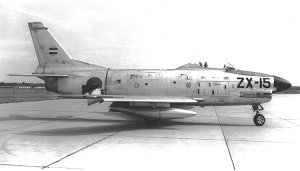
ZX-coded F-86K 54-1239 was lost in a flying accident
on 16th March 1961. (JMG Gradidge)
Delivered in natural metal
finish, KLu Sabres carried markings to denote squadron assignment
in the form of letter/number codes. 700 Sqn aircraft carried '6A-'
codes, 701 Sqn aircraft bore 'Y7-' and 702 Sqn 'ZX-' codes, each aircraft
being then assigned an individual suffix number. In the early 'Sixties,
the code system changed so that all F-86Ks, irrespective of their
squadron, carried a 'Q', followed by the 'last three' of the USAF
serial number. From 1961, Sidewinder launch rails were also incorporated
onto most aircraft, known affectionately as the 'Kaasjager' ('K'-fighter).
Service life of the KLu F-86Ks was relatively short, and a total of
thirteen F-86Ks was lost in flying accidents. With the advent of the
F-104 Starfighter the Sabre fleet began to wind down, and 702 Sqn, their
training commitment complete, disbanded on 1st April 1962. The surviving
aircraft were mostly passed to the remaining squadrons, but from 21st
June 1962, a number of high-time Sabres were permanently withdrawn from
use and sent to FIAT for reconditioning. At the time it was thought
that they would be passed on to the Turkish Air Force, but in reality
all these aircraft (up to ten) were instead assigned to the Italian
AF. Next Dutch unit to disband was 701 Sqn which inactivated during
1963, and 700 Sqn then disbanded on 30th June 1964. The F-86K was officially
withdrawn from KLu service on 31st October 1964. Many of the Sabre personnel
converted en masse onto the Starfighter, but the old F-86K squadron
numbers were never reactivated.
Honduras
With a relatively small armed force, the Fuerza Aerea Hondurena (FAH)
had for many years been supplied only sporadic deliveries of American
MDAP aircraft. Following the infamous 1969 'Soccer War' with El Salvador,
Honduras endeavoured to build up its air force, and the purchase of
eighteen ex-Israeli Dassault MD.450 Ouragan fighter-bombers by El
Salvador in 1973 marked the start of a small arms race. The FAH also
managed to negotiate a contract for a number of ex-Israeli aircraft,
this time for Dassault Super Mystere B2s. But delivery was not immediate,
and desperate to obtain fighter aircraft, Honduras decided not to
wait for the slow negotiations with the Israelis. Instead, eight ex-Yugoslav
Air Force Canadair CL-13 Mk. 4s (F-86E(M) standard) were bought in
1976, just ahead of an Israeli agreement for the supply of the Super
Mysteres. At least two F-86Fs were also supplied (possibly from Venezuela)
at this time.
The Sabres' arrival coincided
with that of the Israeli aircraft. Former Israel Defence Force /Air
Force Lt. Col. Shlomo Shapira was assigned to the FAH, under Israel
Aircraft Industries charge, to train the Honduran pilots. It appears
that the earlier IAI involvement with Iranian F-86Fs came to good
use, for Lt-Col. Shapira also trained the Hondurans in the use of
the Canadair CL-13 Sabres (and possibly later, the F-86Ks). But with
the Super Mysteres forming the main air defence component of the air
force, the Sabres were rendered largely superfluous, and were assigned
to Escuadrilla de Caza-Bombardeo (simply, 'fighter bomber squadron')
at Base Aerea Coronel Hector Caracciolo Moncada, La Ceiba.
It was during this period
that four F-86K all-weather fighters were presented to the FAH by
the Venezuelan government, and these were also, curiously, assigned
to Escuadrilla de Caza-Bombardeo. The F-86Ks carried natural metal
finish throughout their short service life, but the F-86Es and Fs
soon gained a camouflage paint scheme.
It is not known when the
Honduran F-86Ks were retired; it can only be presumed that their complexity
and limited numbers precluded all but the briefest of operational
use. However, the F-86Es did remain in service into the 1980s, thanks
to maintenance support from Venezuela. They were finally retired in
1986.
Italy
The Italian
Air Force (Aeronautica Militare Italiana - AMI) gained Sabre capability
in 1955 with the arrival of the first of around 180 ex-RAF Sabre 4s.
These aircraft had been upgraded to F-86E (M) standard prior to delivery,
and served in the day fighter role.
(missing
photo)
Delivery ceremony for the first seven AMI F-86Ks on
25th July 1955.
With FIAT
building F-86Ks, it was only natural that the AMI would be first to
receive the type in NATO, and 1 Stormo Caccia Ogni Tempo (1st all-weather
fighter group) formed at Istrana in late 1955 for this purpose. The
first squadron to receive the F-86K was 6 Gruppo, which formed in
October 1955, and received its first aircraft on 2nd November. 17
and 23 Gruppi then received the aircraft in 1956, the latter initially
operated as a Sezione (flight) of 1 Stormo Caccia Ogni Tempo at Pisa
from 1st December 1956, and was finally redesignated as a Gruppo on
30th March 1957.
Some considerable
upheaval then affected the Sabre units, not least the conversion of
1 Stormo to guided missile operations in May 1959. This precipitated
the move of the F-86Ks to a pair of units previously flying F-84Fs;
21 Gruppo (gaining ex-17 Gruppo Sabres) and 22 Gruppo (taking over
6 Gruppo aircraft). 23 Gruppo remained an F-86K unit, and all three
numerically consecutive units were reassigned to 51 Aerobrigata control
at Istrana. 21 Gruppo converted to the F-104G in September 1963, passing
its F-86Ks to 12 Gruppo.
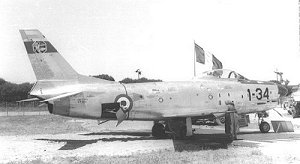
'1-34', an F-86K from 17 Gruppo COT. This machine
is MM6218/53-8306.
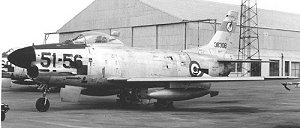
'51-56'/53-8308, an F-86K from 23 Gruppo,
51 Aerobrigata
Meanwhile,
the F-86E units were also realigned, 4 Aerobrigata deploying to Grosetto
starting in March 1959, with 10 Gruppo being detached to Grazzanise
in December 1961. 9 and 10 Gruppi then converted onto F-104s beginning
in March 1963. This left 12 Gruppo, which converted onto F-86Ks at
Gioia del Colle in September 1963. The 2 Aerobrigata F-86Es were lost
in October 1962 with the disbanding of the wing, having moved gruppi
to Cameri and Rimini in 1957. However, 13 Gruppo continued as an autonomous
squadron, the last in the AMI to operate F-86Es. The unit flew the
last AMI F-86E mission at Cameri on 15th August 1965, then moved to
Treviso for conversion to the FIAT G.91R.
(missing photo)
55-4829, a green-trimmed 36 Stormo machine seen at
RAF Luqa, Malta.
The last AMI F-86K had
been delivered from the factory on 31st October 1957, but further
examples were obtained from France, which passed twenty-two F-86Ks
to 51 Aerobrigata, starting in January 1962. By 1967, the Italian
AF had three F-86K squadron-sized units remaining, 23 Gruppo having
moved to Rimini-Miramare in July 1964 and 12 Gruppo reassigning to
the newly-formed 36 Stormo on 1st August 1966. With F-104S deliveries
beginning, 22 Gruppo moved to Cameri on 9th June 1969 for conversion
to the type, passing its remaining Sabres to 12 and 23 Gruppi. In
December 1971, 12 Gruppo also converted to the Starfighter, and any
viable F-86Ks were ceded to the only AMI Sabre unit remaining; 23
Gruppo at Rimini-Miramare. With inevitable conversion to the F-104
in sight, 23 Gruppo was assigned to 5 Stormo on 25th March 1973, receiving
its first F-104S on 19th March 1973. The last AMI F-86K flight was
flown on 27th July 1973 by Capt. Mario Pinna. In service, the F-86Ks
had flown 162,396 hours.
Norway

'2X'-coded F-86K 54-1267
of 337 Skv.
Starting in September
1955, sixty US-built F-86Ks were supplied to Norway, though one of
these aircraft was lost during acceptance trials in America. It was
not replaced until early 1960. The RNoAF's F-86K capability suffered
another blow on 10th March 1956 when four aircraft were destroyed
in a hangar fire at Gardermoen AB near Oslo. These machines were replaced
by four FIAT-built F-86Ks during June 1956. The F-86Ks began to equip
the squadrons in September 1955 with the formation of 337 Skv at Gardermoen.
A second unit, 339 Skv then formed with F-86Ks at Gardermoen in July
1956. These units were then disbanded in September 1963 and merged
their aircraft and personnel into 332 and 334 Skv respectively. Two
F-86F units had earlier converted onto the F-86K: 332 Skv, which moved
into Bodo in the Autumn of 1962 for conversion and then took over
337 Skv F-86Ks, and 334 Skv which converted to F-86Ks in August 1960
and then also gained 339 Skv machines in 1963.
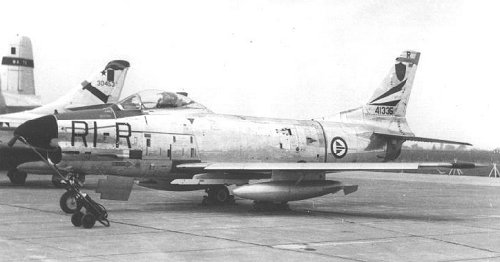
54-1335 was delivered
to the RNoAF on 31st August 1956, and served with 334 Skv (seen here)
and 339 Skv before being withdrawn on 18th August 1967.
Replacement
of the F-86Fs began in April 1963 when 331 Skv received its first
F-104G Starfighters, and F-5s also began arriving in early 1966. As
they were replaced, F-86Fs were largely put through overhaul and sent
on to further MDAP assignment. Many RNoAF F-86Fs served with the Royal
Saudi AF, and in a spares capacity with the Portuguese AF.
The F-86Ks were withdrawn beginning in the autumn of 1964 when 332
Skv was disbanded. 334 Skv was then the last RNoAF unit to operate
Sabres, and retired its last F-86Ks on 15th July 1967. With little
further use, the majority were then scrapped.
Venezuela
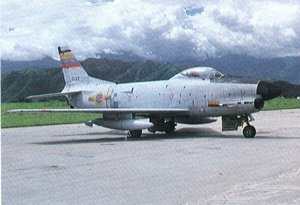
'0132' is ex-56-4124 and is possibly one of four later sent
to Honduras.
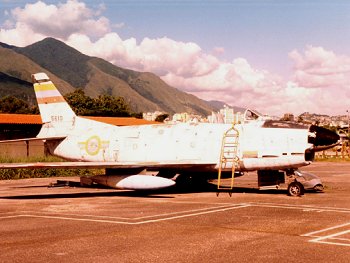
Serialled '5610', this derelict FAV F-86K was seen at La Carlota.
(PR Foster)
During 1965, the Venezuelan
Air Force (Fuerza Aerea Venezolanas - FAV) began negotiations with
the West German government for the purchase of all 'seventy-three'
surviving Luftwaffe F-86Ks, including the unflown examples. Export
licences were approved for fifty-one aircraft (presumably the airworthy
ones), and the sale was worth 50,000 UK pounds ($140,000) per aircraft
, including spares. It was also reported at the time that the deal
included the fitting of recce equipment in some aircraft, but no evidence
can be found to substantiate this. A total of seventy-eight F-86Ks
was eventually supplied, including many unused, non-flyable aircraft
as spares sources. At least four aircraft were impounded at the docks
in Cura?ao on delivery and never made it into service - they were
eventually scrapped, still in their USAF delivery markings. F-86Ks
flew with Escuadras de Caza 34 and 35, and later apparently replaced
the F-86Fs of Esc. de Caza 36. Four aircraft are reported to have
passed to the Honduran AF in 1969 following overhaul, but it seems
more likely that this event occurred some time after 1975. The FAV
F-86Ks encountered many maintenance problems, a large number being
grounded in July 1969 for hydraulic hose problems. Around twenty-seven
were reported to have been written off, with the remainder being withdrawn
at Palo Negro circa 1974. Most are still there, slowly rotting away.